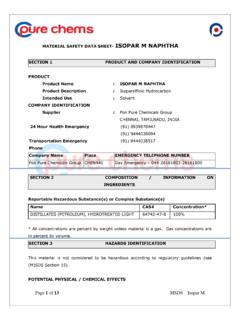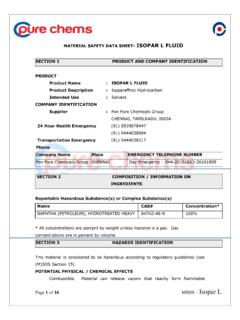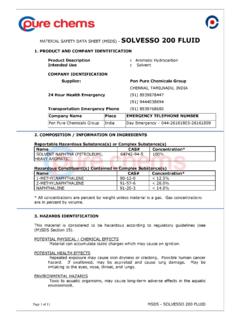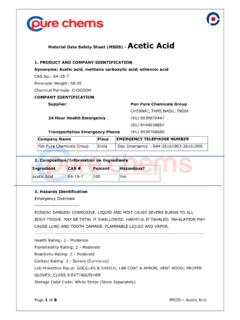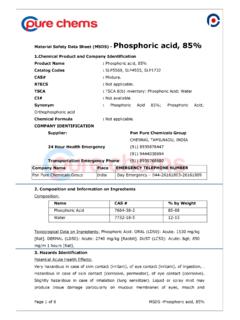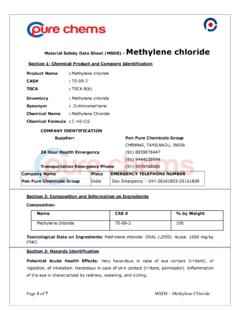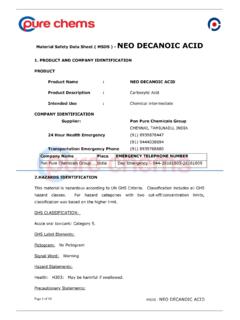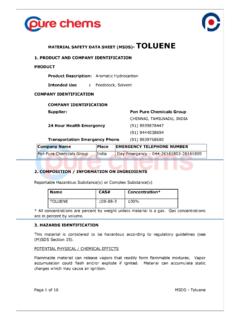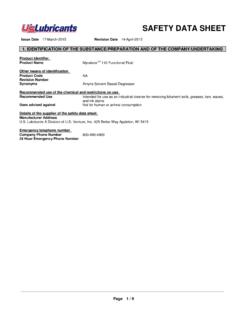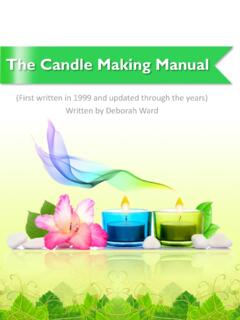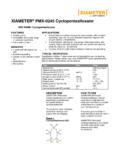Transcription of MATERIAL SAFETY DATA SHEET- ISOPAR G FLUID …
1 Page 1 of 15 MSDS ISOPAR G MATERIAL SAFETY data sheet - ISOPAR G FLUID SECTION 1 product AND company identification product product Name : ISOPAR G FLUID product Description : Isoparaffinic Hydrocarbon Intended Use : Solvent company identification Supplier : Pon Pure Chemicals Group CHENNAI, TAMILNADU, INDIA 24 Hour Health Emergency (91) 8939878447 (91) 9444038694 Transportation Emergency Phone (91) 9444038517 company Name Place EMERGENCY TELEPHONE NUMBER Pon Pure Chemicals Group CHENNAI Day Emergency 044-26161803-26161809 This (M) SDS is a generic document with no country specific information included. SECTION 2 HAZARDS identification This MATERIAL is hazardous according to UN GHS Criteria.
2 Classification includes all GHS hazard classes. For hazard categories with two cut-off/concentration limits, classification was based on the higher limit. GHS CLASSIFICATION: Flammable liquid : Category 3. Skin irritation : Category 3. Aspiration toxicant : Category 1. Chronic aquatic toxicant : Category 2. GHS Label Elements: Pictogram: Page 2 of 15 MSDS ISOPAR G Signal Word : Danger Hazard Statements: Physical : H226: Flammable liquid and vapor. Health : H304: May be fatal if swallowed and enters airways. H316: Causes mild skin irritation. Environmental : H411: Toxic to aquatic life with long lasting effects. Precautionary Statements: Prevention: P210: Keep away from heat/sparks/open flames/hot surfaces.
3 -- No smoking. P233: Keep container tightly closed. P240: Ground/bond container and receiving equipment. P241: Use explosion-proof electrical, ventilating, and lighting equipment. P242: Use only non-sparking tools. P243: Take precautionary measures against static discharge. P273: Avoid release to the environment. P280: Wear protective gloves and eye / face protection. Response: P301 + P310: IF SWALLOWED: Immediately call a POISON CENTER or doctor/physician. P303 + P361 + P353: IF ON SKIN (or hair): Take off immediately all contaminated clothing. Rinse skin with water/shower. P331: Do NOT induce vomiting. P332 + P313: If skin irritation occurs: Get medical advice/attention. P370 + P378: In case of fire: Use water fog, foam, dry chemical or carbon dioxide (CO2) to extinguish.
4 P391: Collect spillage. Storage: P403 + P235: Store in a well-ventilated place. Keep cool. P405: Store locked up. Disposal: P501: Dispose of contents and container in accordance with local regulations. Contains: NAPHTHA (PETROLEUM), HYDROTREATED HEAVY Other hazard information: PHYSICAL / CHEMICAL HAZARDS MATERIAL can accumulate static charges which may cause an ignition. MATERIAL can release vapours that readily form flammable mixtures. Vapour accumulation could flash and/or explode if ignited. HEALTH HAZARDS Repeated exposure may cause skin dryness or cracking. Mildly irritating to skin. May be irritating to the Page 3 of 15 MSDS ISOPAR G eyes, nose, throat, and lungs. ENVIRONMENTAL HAZARDS No additional hazards. NOTE: This MATERIAL should not be used for any other purpose than the intended use in Section 1 without expert advice.
5 Health studies have shown that chemical exposure may cause potential human health risks which may vary from person to person. SECTION 3 COMPOSITION / INFORMATION ON INGREDIENTS This MATERIAL is defined as a complex substance. Hazardous Substance(s) or Complex Substance(s) required for disclosure Name CAS# Concentration* GHS Hazard Codes NAPHTHA (PETROLEUM), HYDROTREATED HEAVY 64742-48-9 100% H226, H304, H316, H411 Hazardous Constituent(s) Contained in Complex Substance(s) required for disclosure Name CAS# Concentration* GHS Hazard Codes NONANE 111-84-2 1 - < 5% H226, H304, H336, H316 * All concentrations are percent by weight unless ingredient is a gas. Gas concentrations are in percent by volume. Concentration values may vary. SECTION 4 FIRST AID MEASURES INHALATION Remove from further exposure.
6 For those providing assistance, avoid exposure to yourself or others. Use adequate respiratory protection. If respiratory irritation, dizziness, nausea, or unconsciousness occurs, seek immediate medical assistance. If breathing has stopped, assist ventilation with a mechanical device or use mouth-to-mouth resuscitation. SKIN CONTACT Wash contact areas with soap and water. Remove contaminated clothing. Launder contaminated clothing before reuse. Page 4 of 15 MSDS ISOPAR G EYE CONTACT Flush thoroughly with water. If irritation occurs, get medical assistance. INGESTION Seek immediate medical attention. Do not induce vomiting. ACUTE AND DELAYED SYMPTOMS/EFFECTS See Toxicological Section NOTE TO PHYSICIAN If ingested, MATERIAL may be aspirated into the lungs and cause chemical pneumonitis.
7 Treat appropriately. SECTION 5 FIRE FIGHTING MEASURES EXTINGUISHING MEDIA Appropriate Extinguishing Media: Use water fog, foam, dry chemical or carbon dioxide (CO2) to extinguish flames. Inappropriate Extinguishing Media: Straight streams of water FIRE FIGHTING Fire Fighting Instructions: FLAMMABLE. Evacuate area. Prevent run-off from fire control or dilution from entering streams, sewers or drinking water supply. Fire-fighters should use standard protective equipment and in enclosed spaces, self-contained breathing apparatus (SCBA). Use water spray to cool fire exposed surfaces and to protect personnel. Unusual Fire Hazards: Vapour is flammable and heavier than air. Vapour may travel across the ground and reach remote ignition sources, causing a flashback fire danger.
8 Hazardous MATERIAL . Firefighters should consider protective equipment indicated in Section 8. Hazardous Combustion Products: Incomplete combustion products, Oxides of carbon, Smoke, Fume FLAMMABILITY PROPERTIES Flash Point [Method] : >40 C (104 F) [ASTM D-56] Flammable Limits (Approximate volume % in air): LEL: UEL: Auto ignition Temperature : 365 C (689 F) Page 5 of 15 MSDS ISOPAR G SECTION 6 ACCIDENTAL RELEASE MEASURES NOTIFICATION PROCEDURES In the event of a spill or accidental release, notify relevant authorities in accordance with all applicable regulations. PROTECTIVE MEASURES Avoid contact with spilled MATERIAL . Warn or evacuate occupants in surrounding and downwind areas if required, due to toxicity or flammability of the MATERIAL .
9 See Section 5 for fire fighting information. See the Hazard identification Section for Significant Hazards. See Section 4 for First Aid Advice. See Section 8 for advice on the minimum requirements for personal protective equipment. Additional protective measures may be necessary, depending on the specific circumstances and/or the expert judgment of the emergency responders. For emergency responders: Respiratory protection: half-face or full-face respirator with filter(s) for organic vapor and, when applicable, H2S, or Self Contained Breathing Apparatus (SCBA) can be used depending on the size of spill and potential level of exposure. If the exposure cannot be completely characterized or an oxygen deficient atmosphere is possible or anticipated, SCBA is recommended.
10 Work gloves that are resistant to aromatic hydrocarbons are recommended. Note: gloves made of polyvinyl acetate (PVA) are not water-resistant and are not suitable for emergency use. Chemical goggles are recommended if splashes or contact with eyes is possible. Small spills: normal antistatic work clothes are usually adequate. Large spills: full body suit of chemical resistant, antistatic MATERIAL is recommended. SPILL MANAGEMENT Land Spill: Eliminate all ignition sources (no smoking, flares, sparks or flames in immediate area). Stop leak if you can do so without risk. All equipment used when handling the product must be grounded. Do not touch or walk through spilled MATERIAL . Prevent entry into waterways, sewer, basements or confined areas.
